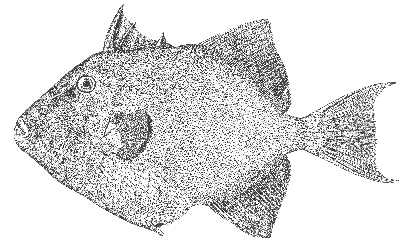Triggerfish Balistes carolinensis Gmelin 1789 [86]
[Jordan and Evermann, 1896-1900, p. 1701.]

Figure 275.—Triggerfish (Balistes carolinensis), New York. From Goode. Drawing by H. L. Todd.
Description—
The readiest field marks for the triggerfish are its deep, sidewise-flattened body with slender caudal peduncle; its small terminal mouth with both dorsal and ventral profiles of the nose nearly straight; its eye situated so high as to give its face a very peculiar aspect; its large projecting incisor teeth; its very short gill openings wholly above the insertions of the pectorals; the plate armor of thick scales with which its entire head and body are clad; and especially its unusually stout first dorsal spine.
The spiny dorsal fin is triangular, with three spines, the first so stout that it is more like a horn, situated close behind the eyes and with the second spine acting as a trigger to lock the first spine [page 521] erect, whence the common name of the fish. The soft dorsal fin (27 rays) is separated from the first by a considerable interspace, is rhomboid in outline with the third or fourth ray longest, and tapers back to the base of the caudal peduncle. The anal fin (25 rays) corresponds to the soft dorsal in outline and in location. The caudal fin is of moderate size, its rear margin moderately concave, in a very characteristic curve, with sharp pointed, somewhat prolonged corners. The pectorals are short, rounded, and situated below the gill openings. The ventrals are reduced to one short, stout, blunt spine, mostly embedded in the skin and they are connected with the general outline of the abdomen by a sort of dewlap.
Color—
The colors of this triggerfish vary widely. A specimen 2 inches long recently taken on Georges Bank was yellowish, with many small blue-violet spots on the sides, dusky-blotched along the back, and with one broad, irregular dusky band extending from the base of the dorsal fin almost to the anal. The caudal fin was pale yellow. Other examples have been described as olive gray, marked with violet dots and with dark crossbars, the fins as variously tinted with yellow, blue, and olive.
Size—
Said to reach a weight of 4 pounds, but they average only about 1 pound.
General range—
Both sides of the tropical Atlantic, also the Mediterranean; straying north to Ireland on the European coast; to the outer coast of Nova Scotia, in the vicinity of Cape Canso[87] on the American side.
Occurrence in the Gulf of Maine—
Only one specimen of this tropical fish, taken in the Squam River at Annisquam, near Gloucester, Mass., many years ago,[88] had been reported from the Gulf of Maine previous to 1925. But it must drift in over the offshore rim of the Gulf more often than had been suspected, for two small fry of 2 to 3 inches were picked up on the northeast part of Georges Bank among Gulf weed (Sargassum) from the Albatross II, in mid-September 1927; a large one about 15 inches long was gaffed at the surface from the fishing schooner Huntington Sanford 14 miles southeasterly from Highland Light, Cape Cod, on July 19, 1929;[89] one, now in the Museum of Comparative Zoology, was picked up at Plymouth, Mass., on September 5, 1932, by the late C. L. Hauthaway, a well-known angler and a close observer.[90] One was reported from Casco Bay, (Small Point), Maine, in 1949, and one near Boothbay Harbor (Linekin Bay), also in 1949.[91]
[86] Jordan, Evermann, and Clark (Rept. U. S. Fish Comm. (1928), Pt. 2, 1930, p. 491) prefer the name capriscus Gmelin, and correctly so, from the strictly nomenclatural standpoint. But carolinensis is preferable both because it appeared on an earlier page of the same publication, and because the great majority of references to the species have been under that name.
[87] Nova Scotian records are from Halifax and from Queensport near Cape Canso (Vladykov, Proc. Nova Scotian Inst. Sci., vol. 19, 1935, p. 9; McKenzie Proc. Nova Scotian Inst. Sci., vol. 20, 1939, p. 18); also 24 miles southeasterly from Sable Island, where one was picked up by the schooner Wanderer, July 5, 1931 (Firth, Bull. 61, Boston Soc. Natural History, 1931, p. 13).
[88] This specimen is now in the Museum of Comparative Zoology.
[89] Reported by Firth, Bull. No. 61, Boston Soc. Nat. Hist., 1931, p. 12.
[90] Another species of trigger fish (Balistes vetula) is more common than carolinensis at Woods Hole, and is recorded from Nantucket, but it has not been taken in the Gulf of Maine as yet. It is separable from carolinensis by the fact that the forward rays of its soft dorsal fin and the corners of its caudal fin are elongated and filamentous; also by the presence of two blue bars on each side of its head.
[91] These last two fish were reported by Scattergood, Trefethen, and Collin, (Copeia, 1951, No. 4, p. 298).